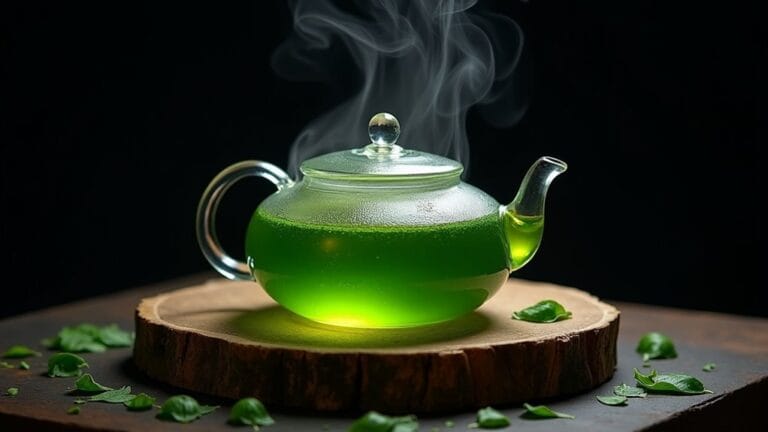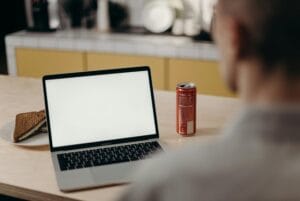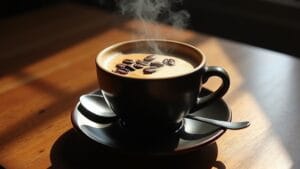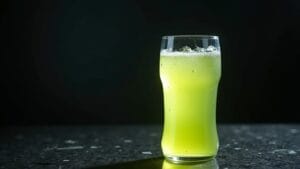Understanding Green Tea Caffeine Content
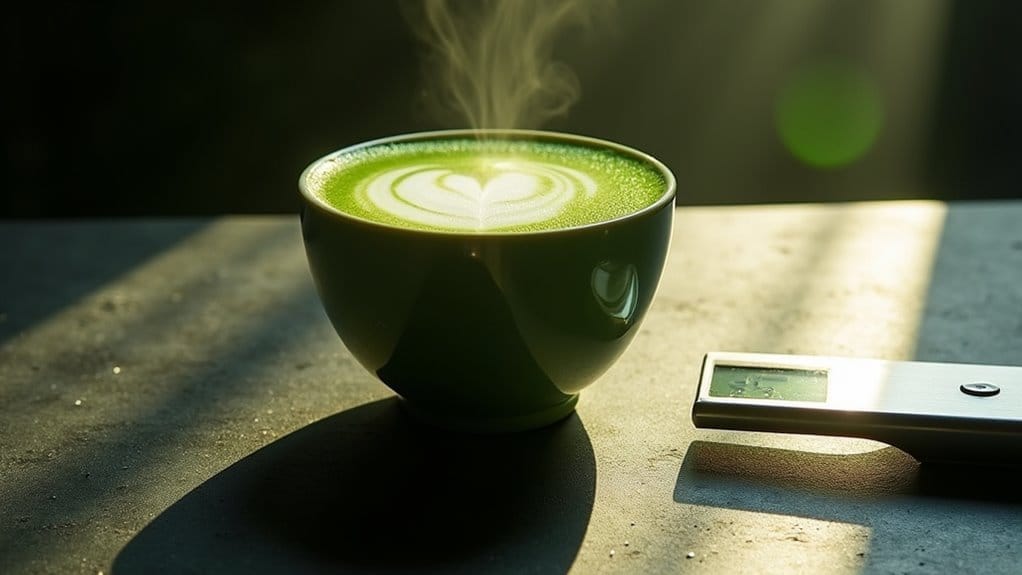
Bouncy brunch mug fact: green tea gift-wraps a teeny orb of pep that can scoot from 14 to 61 milligrams in one regular six-to-eight-ounce cup, and that gentle spark rides sidekick with L-theanine so the zip feels like laser-tag, not stampeding lions. younger leaves carry more caffeine than mature ones, which is why spring-harvest blends often punch up the mg count.
So, how many mg of caffeine in green tea? Picture about 20–50 mg chilling in most cups, which is way less than coffee’s 96 mg coffee punch, and it’s also lower than the caffeine content of green tea vs black (black hits around 48 mg).
That’s why green tea gives calm buzz minus coffee jitters. Decaf versions keep it under 12 mg, and herbal buddies rock zero caffeine.
Green Tea Caffeine Amounts by Type
Since one green tea leaf does not fit all mugs, caffeine levels hop around like bouncy popcorn depending on the type you pick! For super clarity, peek this tiny chart to nail down how much caffeine in green tea is hiding in each cup.
| Tea Type | MG Caffeine |
|---|---|
| Matcha | 60–70 |
| Gyokuro | 35–50 |
| Sencha | 30–40 |
The numbers show how many milligrams of caffeine in green tea swing lower than coffee’s big 95–200 punch, so greenies can sip buzz minus the jitters. Matcha rules because you drink the whole leaf. Gyokuro adds shade-grown magic, while Sencha keeps things mild and grassy. Fukamushi Sencha boosts caffeine a tick above regular Sencha thanks to deeper steaming.
Green Tea vs Coffee vs Black Tea Caffeine Comparison
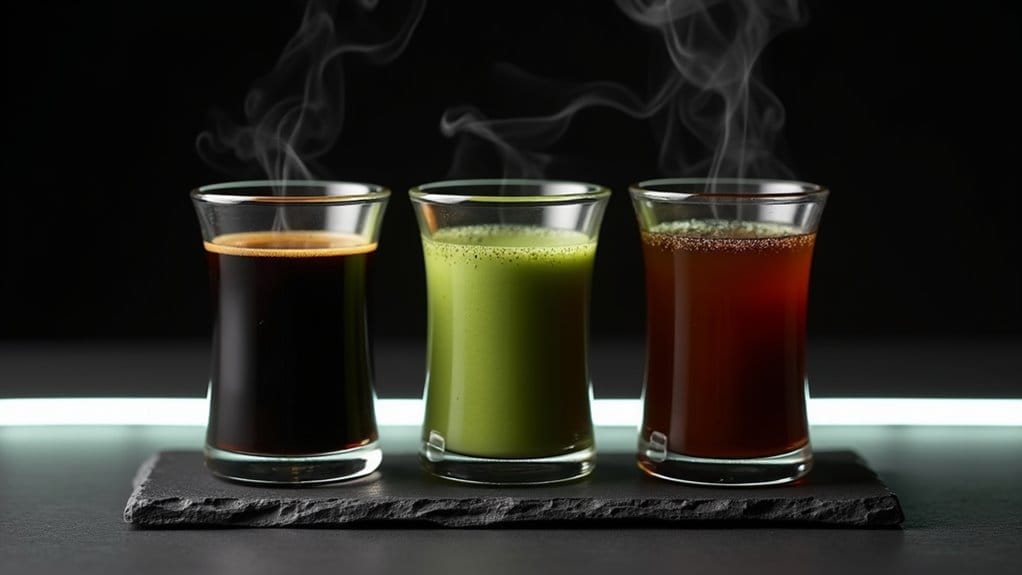
Because caffeine numbers can feel like a wild ride, let’s line them up like toy soldiers and peek who packs the biggest punch!
| Drink | Caffeine (8 oz) |
|---|---|
| Coffee | 80–175 mg |
| Black tea | 40–70 mg |
| Green tea | 20–45 mg |
Coffee crushes, black tea floats in the middle, green tea keeps it chill yet alert. So, how much caffeine in one cup of green tea? About 20–45 mg, averaging 35 mg. That’s roughly half the kick of black tea and way shy of drip coffee. g wise, the same cup holds roughly 0.02–0.045 g of caffeine. Simple as that, match and win!
What Controls Caffeine Levels in Your Green Tea
Three things decide how much kick your green tea gives you:
how long and how hot you brew it,
the fan-(cough)-tastic way it was processed,
and whether you picked loose leaves or the stressed-out crumbs in bags.
Brewing Time and Water Temperature Effects
If you want a caffeine improvement without flipping out, the two dials you’ve gotta turn are how long the leaves sit in hot water and how hot that water actually is.
A one-minute splash pulls about 12 mg caffeine, two extra minutes hits 22 mg, and five pushes near 41 mg—almost four times the kick!
Most folks aim for the sweet spot: three minutes at 176° F (80° C). Cooler water mellows the buzz, hotter water speeds it up but can blast bitter polyphenols everywhere.
Push past five minutes or crank the burner above 95° C and the taste tumbles. Dial time, dial heat, and sip your own rocket enhancement.
Tea Quality and Processing Methods
So, you just nailed the “how long and how hot” game for a quick caffeine bump, but what if the buzz still leaves you snoring?
Plant tricks matter! Shade cloth freaks the bush into pumping extra caffeine, so kabuse-cha leaves scream louder than sunny sencha.
The top baby leaf and tiny bud pack the biggest punch, while older, lower stuff like bancha or twiggy kukicha barely whispers.
Steaming keeps the kick lively; pan-frying knocks it down a notch, and the roasty dance of houjicha kicks most of it right out the window!
Crush leaves into powder and you swallow every scrap—matcha hits like fear-driven rocket fuel, stems removed and all.
Pick smart tweak roast, and caffeine obeys like a tired puppy.
Tea Bags vs Loose Leaf Differences
Tiny shrimplike flecks in ordinary bags race caffeine out the gate, while big, tidy loose leaves clomp along like slowpoke tortoises; still, each camp hides one or two sneaky cards that decide how wired your mug can get, and we’re about to flip them all, giggle by giggle!
Bag dust is tiny, so tons of tea cells touch water at once; loose leaves stay whole, so caffeine escapes in slo-mo sips.
Pre-portioned 2 g bags cap each cup’s jolt, yet you can dump five bags for a mega dose. Loose leaf’s “how much did I scoop?” game lets a mountain of leaves double caffeine in one cup.
Re-steep loose leaf and caffeine fades sip by sip; grab a fresh bag and boom—new zap each time.
How to Control Caffeine in Your Green Tea
Mastering your morning buzz starts right in your teacup, and it’s way simpler than you might think!
- Use fewer leaves—2.5 grams instead of 5 grams—to instantly cut caffeine in half.
- Steep for just 45 seconds instead of a minute, because caffeine creeps out slower.
- Turn down the water to 140°F; cooler water keeps the punch gentle.
- Pick roasted hojicha or ditch the very initial splash, and you’ll dodge extra jitters!
Health Considerations and Daily Limits
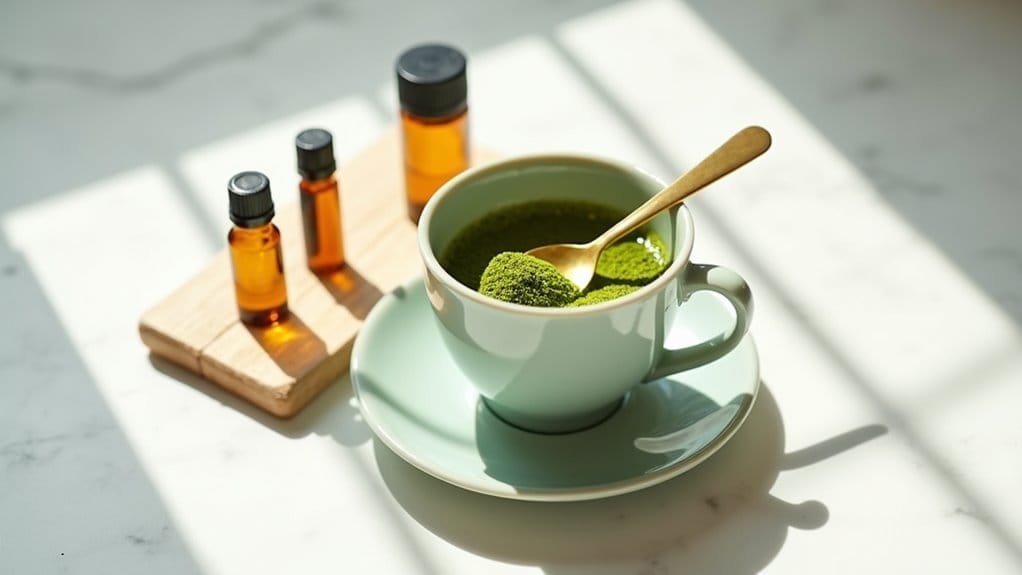
Stick to about 400 mg of caffeine a day for grown-ups, or just 200 mg if you’re expecting a baby—that’s four big green teas or two regular coffees, max!
Green tea gives you calm focus and way fewer jitters than coffee, so picking it over java is a smart move when your nerves are already jumpy.
Keep cups before noon and skip them after 3 p.m., so the green-giggles don’t turn into midnight stare-athons at the ceiling fan.
Safe Daily Caffeine Intake Guidelines
Daily caffeine rules are like a friendly speed limit—you stay inside the lines, and life stays fun!
Healthy grown-ups can cruise up to 400mg, roughly four coffees, without flipping the speed wobble switch.
Pregnant or nursing? Straitjacket at 200mg to keep the baby drive smooth.
Kids under twelve get a total caffeine roadblock, while teens can tap 100mg and no nitro.
Caffeine powders are dragster fuel—one tiny teaspoon equals 28 cups, so steer clear!
Genetics, meds, and body size act like the dashboard telling each person their own redline—listen to it, and the ride stays groovy.
When to Choose Green Tea Over Coffee
Why reach for green tea instead of that steamy coffee mug sometimes?
Green tea slides in with only 20-35 mg of caffeine, way less than coffee’s 95-100 mg, so the hands shake less and the brain stays calm yet alert, thanks to the magic combo of L-theanine.
The catechins in green tea act like tiny bodyguards, lowering bad cholesterol, cooling inflammation, and even revving metabolism a notch. Sensitive stomachs, anxiety-prone minds, or anyone watching caffeine intake can swap the espresso punch for green tea’s gentle wave.
Cardiovascular risk folks get extra protection.
Bottom line: mild buzz, big protection, zero jitter drama.
Sleep Impact and Timing Recommendations
Although green tea looks calm and gentle, it still packs enough caffeine (about 20-35 mg a mug) to mess with someone’s snooze time!
Action plan: skip cups after 3 p.m., because caffeine hangs around for up to five hours and can ping the brain at midnight like a chatty raccoon!
Try low-caffeine green instead after lunch; studies show it cools stress enzymes and helps older sleepers snooze longer and deeper.
Dial back to zero caffeine within six hours of bedtime, and everyone from students to grandpas can dream like puppies instead of counting ceiling cracks!
Drink smart, sleep dreamy—easy!
Conclusion: Making Smart Green Tea Choices
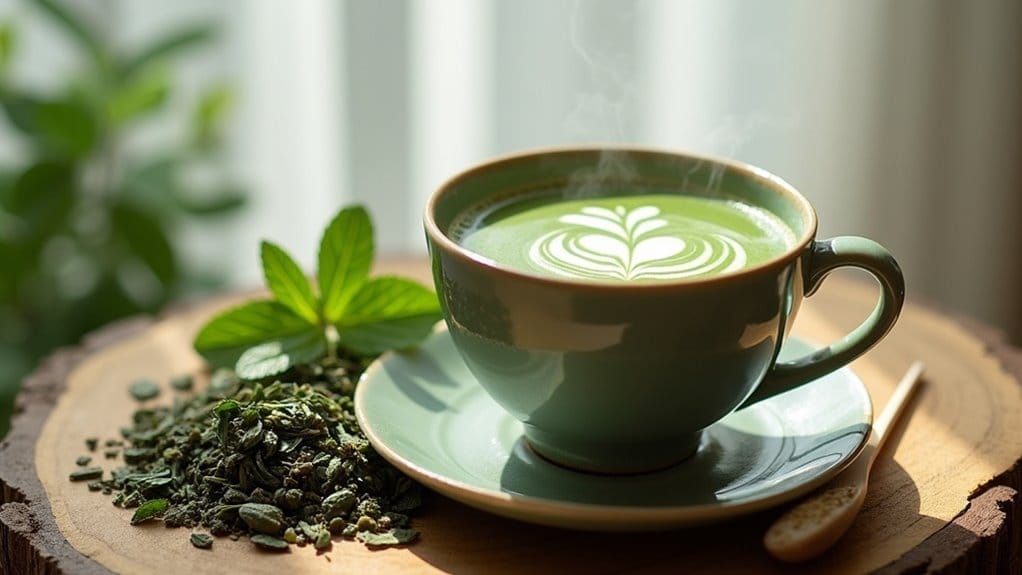
Because people want their cup to feel just right—not too sleepy, not bouncing off the walls—grasping the caffeine quirks of green tea is the smartest trick ever.
Each leaf hides its own buzz level: matcha packs a 60-70 mg punch, gyokuro hits 35-50 mg, senha floats 30-40 mg, while humble bancha whispers a gentle 15 mg, so choose like picking sneakers for the right race!
Young leaves, initial harvest, and shady shade enhance the buzz, but short steeps or older leaves chill it out—fun, right?
Morning warriors grab matcha or gyokuro; night owls sip bancha to dodge sheep-counting contests. Adjust leaf amount, water temp, and steep time like tuning the volume button on a karaoke machine until your taste buds and sleep schedule both cheer!
Frequently Asked Questions
Does Matcha Powder Contain More Caffeine Than Brewed Green Tea?
Does matcha powder contain more caffeine than brewed green tea? Objectively: yes. Standard eight-ounce matcha yields sixty to seventy milligrams caffeine; equivalent brewed green infusion averages around twenty-five milligrams.
Is Cold Brew Green Tea Lower in Caffeine Than Hot Tea?
Cold-brewed green tea ordinarily carries particularly lower caffeine than its hot-brewed counterpart owing to diminished extraction efficiency under cooler, prolonged steeping, although leaf dosage adjustments can narrow the differential.
Can Green Tea Affect Birth Control Pill Absorption?
Caffeine’s half-life doubles on birth control pills; green tea absorption unaltered, prolonged caffeine persists.
Should Children Drink Green Tea for Caffeine?
Discussing whether children should drink green tea for caffeine reveals that pediatric consensus advises complete avoidance under twelve; older youths face risk of exceeding safe daily maximums and associated behavioral and sleep disruptions.
Does Decaf Green Tea Still Have Some Caffeine?
“Nearly none” deceives; residual caffeine persists despite decaf labels. Typical decaf green tea yields two milligrams caffeine per cup, an ineradicable portion Camellia sinensis retains through CO₂ extraction. Complete zero unattainable.

